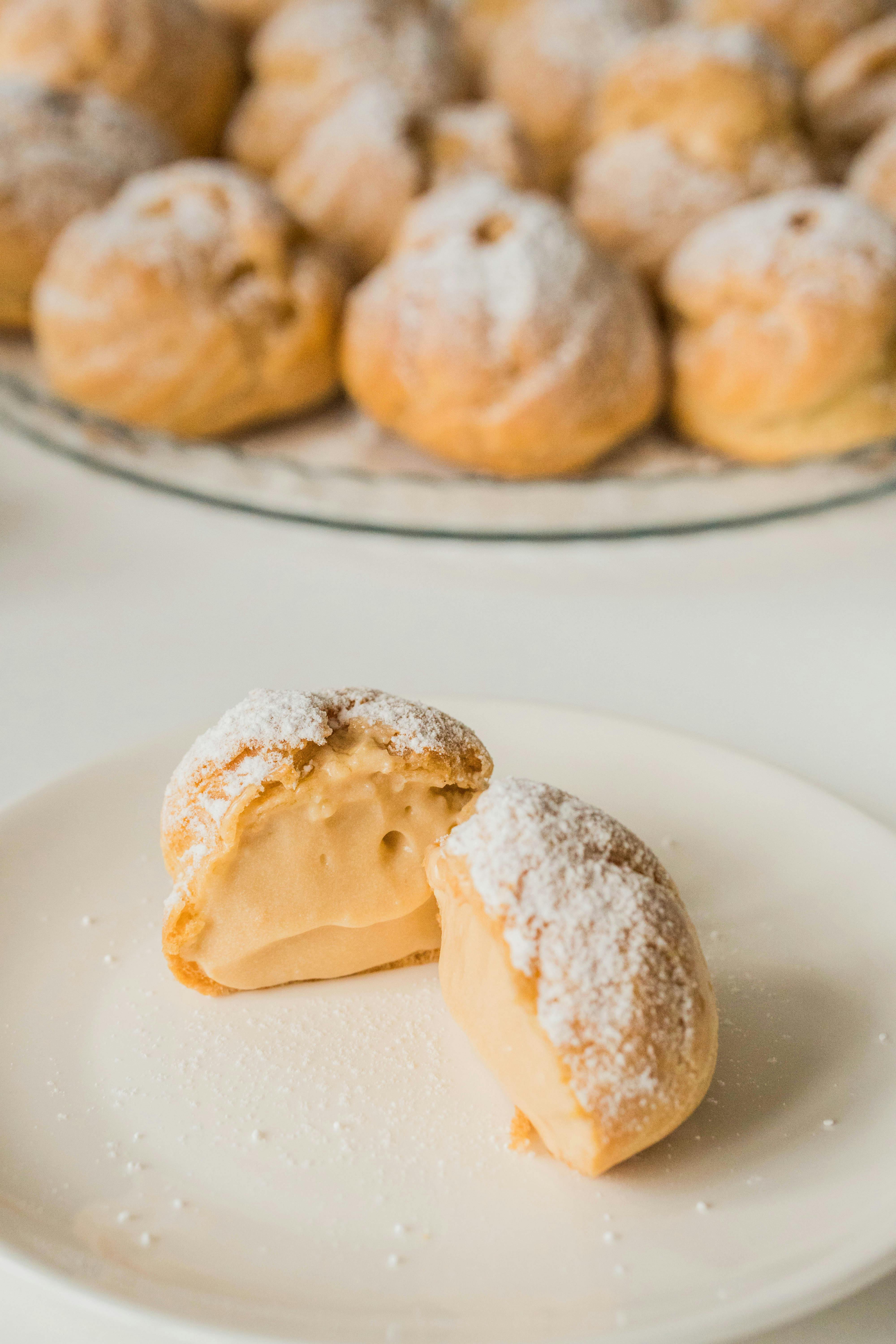Have you ever wondered how Korean ingredients are making their way into the world of baking? From kimchi-infused bread to matcha-filled pastries, a new wave of culinary creativity is taking the baking scene by storm. In this article, we’ll explore the emerging trends in using Korean ingredients in baking, uncovering unique flavors and techniques that are sure to tantalize your taste buds. So get ready to embark on a flavorful journey as we dive into the exciting world of Korean-inspired baking!

1. Korean Ingredients in Traditional Baking
Incorporating Korean flavors in traditional baking recipes
In recent years, there has been a growing trend in incorporating Korean flavors into traditional baking recipes. Korean cuisine is known for its bold and unique flavors, and now bakers all over the world are starting to experiment with these ingredients to create exciting and delicious baked goods. From using ingredients like gochujang (fermented red chili paste) in chocolate brownies to adding green tea powder (matcha) to cupcakes, the possibilities are endless. By adding a touch of Korean flavor to traditional baking recipes, you can elevate your creations and give them a modern twist.
Using Korean spices and seasonings in baked goods
Korean spices and seasonings are known for their depth of flavor and complexity. Ingredients like garlic, ginger, soy sauce, and sesame oil are staples in Korean cuisine, and they can be used to add a unique and savory twist to your baked goods. Imagine the aroma of garlic bread infused with Korean garlic, or the rich umami flavor of soy sauce in a fluffy swiss roll. By incorporating these spices and seasonings into your baked goods, you can create a fusion of flavors that will wow your taste buds.
How Korean ingredients enhance the taste and aroma of baked goods
Korean ingredients bring a whole new dimension of taste and aroma to baked goods. For example, using roasted soybean powder (konggaru) in bread can add a nutty flavor and a slightly grainy texture. Adding black sesame seeds to cookies not only creates a visually striking contrast but also imparts a subtly roasted flavor. Korean ingredients are often used to enhance the natural sweetness of baked goods by adding depth and complexity to the flavors. Whether you’re a seasoned baker or a beginner, incorporating Korean ingredients will take your baked goods to a whole new level of deliciousness.
2. Fusion Baking with Korean Ingredients
Combining Korean ingredients with Western baking techniques
Fusion baking is all about combining different culinary traditions to create something unique and exciting. Korean ingredients are perfect for fusion baking because they can be seamlessly incorporated into Western baking techniques. For example, using Korean rice flour (mochiko) in a traditional French macaron recipe can result in a gluten-free and chewy texture that is reminiscent of Korean rice cakes. By combining the best of both worlds, you can create baked goods that are a delightful fusion of flavors and textures.
Creating unique and innovative baked goods with a Korean twist
With the rise of fusion baking, bakers all over the world are getting creative with Korean ingredients to invent new and innovative baked goods. From kimchi-filled croissants to red bean paste-filled donuts, the possibilities are endless. By embracing the unique flavors of Korean cuisine, you can create baked goods that are both delicious and unexpected. Incorporating ingredients like gochujang, kimchi, and Korean pear can add a delightful twist to familiar recipes and surprise your taste buds.
Exploring the creative possibilities of fusion baking
Fusion baking allows for endless creativity, as it encourages bakers to think outside the box and experiment with different flavors and techniques. Korean ingredients provide a whole new palette of flavors to work with, allowing bakers to create unique flavor combinations that are both exciting and delicious. For example, using Korean chili flakes (gochugaru) in a chocolate cake can add a subtle heat that perfectly complements the richness of the chocolate. By exploring the creative possibilities of fusion baking with Korean ingredients, you can create baked goods that are truly memorable.

3. Health Benefits of Korean Ingredients in Baking
Highlighting the nutritional benefits of Korean ingredients
Korean ingredients are not only delicious but also offer a range of health benefits. For example, Korean red ginseng is known for its antioxidant properties and is often used in baking to boost the immune system. Korean honey, which is rich in vitamins and minerals, can be used as a natural sweetener in baked goods. By incorporating these nutritious ingredients into your baking, you can create treats that not only taste great but also provide added health benefits.
Using Korean superfoods in baking for added health benefits
Korea is known for its superfoods, which are nutrient-dense ingredients that provide a range of health benefits. From seaweed to black garlic, these superfoods can be incorporated into your baking to add an extra nutritional punch. For example, using seaweed powder in bread can increase the fiber content and add a unique umami flavor. Adding black garlic to cookies can provide antioxidants and a subtle sweetness. By using Korean superfoods in your baking, you can create treats that are not only delicious but also nourishing.
Delicious and nutritious alternatives to traditional baking ingredients
Korean ingredients can also be used as delicious and nutritious alternatives to traditional baking ingredients. For example, Korean rice flour can be used as a gluten-free alternative to regular flour, creating baked goods that are suitable for those with dietary restrictions. Korean pear, with its natural sweetness, can be used as a healthier substitute for sugar. By exploring these alternatives, you can create baked goods that are not only healthier but also full of flavor.
4. Locally Sourcing Korean Ingredients for Baking
Exploring local Korean markets for authentic ingredients
If you’re interested in incorporating Korean flavors into your baking, one of the best places to start is your local Korean market. These markets often carry a wide variety of authentic Korean ingredients, from spices and seasonings to unique flours and sweeteners. By exploring your local Korean market, you can find ingredients that are not typically available in mainstream grocery stores, allowing you to create truly authentic Korean-inspired baked goods.
Supporting local Korean farmers and businesses
By sourcing your Korean ingredients locally, you are not only accessing the freshest and most authentic products but also supporting local Korean farmers and businesses. Many Korean ingredients are sourced directly from small farms and artisanal producers, who take pride in their craft and are dedicated to preserving traditional Korean flavors. By choosing to support these local businesses, you are contributing to the preservation of Korean culinary heritage and ensuring that these unique ingredients continue to be available for future generations.
Finding Korean ingredients online for convenience and accessibility
If you don’t have access to a local Korean market, don’t worry! There are many online stores that specialize in Korean ingredients and can deliver them straight to your doorstep. These online stores offer a wide range of products, from pantry staples to specialty items, making it convenient and accessible to incorporate Korean flavors into your baking. By shopping online, you can explore a vast selection of Korean ingredients and have them delivered to your home, allowing you to experiment with new flavors and expand your baking repertoire.

5. Exploring Unique Korean Ingredients for Baking
Introducing lesser-known Korean ingredients used in baking
Korean cuisine is rich in unique and lesser-known ingredients that can add a special touch to your baked goods. Ingredient such as roasted soybean powder (konggaru), black sesame seeds, and sweet potato starch (goguma) can all be used to create delicious and unexpected flavors. Roasted soybean powder adds a nutty flavor and a slightly grainy texture to breads and cookies. Black sesame seeds provide a subtly roasted flavor with a visually striking contrast. Sweet potato starch can create a chewy and addictive texture in baked goods. By exploring these unique Korean ingredients, you can create baked goods that stand out from the crowd.
How to incorporate ingredients like ginseng, roasted soybean powder, and black sesame into baked goods
Incorporating unique Korean ingredients into your baked goods is easier than you might think. For example, ginseng can be infused into liquids like milk or water and used as a flavoring agent in cakes or cookies. Roasted soybean powder can be substituted for a portion of the flour in bread or cookie recipes, adding a unique flavor and texture. Black sesame seeds can be ground and used in doughs or sprinkled on top of baked goods for both flavor and visual appeal. By experimenting with these ingredients, you can create baked goods that have a distinctly Korean twist.
Experimenting with new flavors and textures
When it comes to baking with Korean ingredients, don’t be afraid to get creative and experiment with new flavors and textures. Korean cuisine is known for its balance of sweet, savory, spicy, and tangy flavors, and incorporating these flavors into your baking can result in surprising and delightful combinations. For example, adding kimchi to savory pastries can create a tangy and slightly spicy flavor that pairs perfectly with the buttery pastry. Matcha powder (green tea powder) can be used in a variety of baked goods to add a unique earthy flavor and vibrant green color. By embracing new flavors and textures, you can take your baking to new and exciting heights.
6. Traditional Korean Desserts and Baking Techniques
Learning about traditional Korean desserts
Traditional Korean desserts, known as “hansik,” have a long and rich history that dates back centuries. These desserts are often made with natural and wholesome ingredients, such as rice, beans, fruits, and honey. From rice cakes (tteok) to sweet rice punch (sikhye), traditional Korean desserts are beloved for their delicate flavors and textures. By learning about these desserts and their traditional baking techniques, you can gain a deeper appreciation for Korean culinary heritage and incorporate elements of these time-honored traditions into your own baking.
Adapting Korean baking techniques in modern recipes
Korean baking techniques are grounded in a deep understanding of the ingredients and how they interact with each other. For example, the “tangzhong” method, which involves creating a roux with flour and water, is commonly used in Korean bread baking to create soft and fluffy bread. By adapting these techniques in modern recipes, you can achieve superior texture and flavor in your baked goods. Experiment with techniques like fermentation, steaming, and frying to add a Korean twist to your baking creations.
Preserving cultural heritage through baking
Baking can be a powerful way to preserve and celebrate cultural heritage. By incorporating traditional Korean desserts and baking techniques into your repertoire, you are helping to keep these culinary traditions alive and passing them on to future generations. Whether you’re baking for yourself or sharing your creations with others, you are contributing to the preservation of cultural heritage and ensuring that these traditions continue to thrive.

7. Korean Ingredients in Gluten-free and Vegan Baking
Using Korean ingredients as alternatives in gluten-free baking
For those with gluten sensitivities or celiac disease, Korean ingredients can be a great alternative in gluten-free baking. Korean rice flour, made from finely milled rice, is naturally gluten-free and can be used as a substitute for wheat flour in a variety of baked goods. Korean sweet potato starch, another gluten-free ingredient, can be used to create chewy and delicious textures in pastries and breads. By using these ingredients as alternatives, you can create gluten-free baked goods that are both tasty and suitable for dietary restrictions.
Creating vegan baked goods with Korean ingredients
Korean cuisine has a variety of vegan-friendly ingredients that can be incorporated into your baking to create delicious vegan treats. Korean sweet rice can be used in desserts to create a sticky and chewy texture without the need for eggs or dairy. Korean red bean paste (pat) is often used as a filling in steamed buns and can be a great alternative to traditional buttercream or custard fillings. By exploring these vegan options, you can create baked goods that are suitable for those following a plant-based diet or have dairy and egg allergies.
Catering to dietary restrictions with Korean flavors
Korean flavors can add an exciting twist to gluten-free and vegan baked goods, allowing those with dietary restrictions to enjoy a wide range of flavors. For example, using gochujang in a gluten-free bread recipe can add a spicy and savory kick, while adding Korean pear to a vegan cake can bring a natural sweetness and moisture. By incorporating these flavors into your gluten-free and vegan baking, you can create treats that are not only suitable for dietary restrictions but also bursting with flavor.
8. Exploring Sweet and Savory Korean Baked Goods
Discovering sweet Korean breads and pastries
Korean cuisine is not only famous for its savory dishes but also for its wide variety of sweet breads and pastries. From fluffy milk bread to sweet red bean buns, these treats are beloved in Korea and are gaining popularity worldwide. Korean bakeries are known for their attention to detail and dedication to quality, resulting in sweet breads and pastries that are both visually stunning and delicious. By exploring these sweet Korean baked goods, you can experience the unique flavors and textures that have captivated people for generations.
Exploring savory Korean baked goods like street food snacks
Korean street food is known for its wide range of savory snacks, many of which are baked. From hotteok (sweet filled pancakes) to gyeranppang (egg bread), these snacks are popular street food items in Korea. They are enjoyed by many for their convenience and tasty flavors. By exploring savory Korean baked goods, you can bring a unique twist to your baking and experiment with flavors that are both comforting and satisfying.
Blending sweet and savory flavors for unique taste sensations
Blending sweet and savory flavors is a hallmark of Korean cuisine, and this can be applied to baking as well. By incorporating ingredients like kimchi, gochujang, and soy sauce into your sweet baked goods, you can create unique taste sensations that are both surprising and delicious. For example, adding a hint of gochujang to a caramel sauce can create a sweet and spicy glaze that pairs perfectly with a buttery cake. By blending sweet and savory flavors, you can create baked goods that push the boundaries of traditional flavor combinations and excite your taste buds.

9. Influence of K-Pop and Korean Wave on Baking Trends
How the popularity of K-Pop and Korean dramas has influenced baking trends
The global popularity of K-Pop and Korean dramas, often referred to as the Korean Wave or Hallyu, has not only influenced the entertainment industry but also had a significant impact on baking trends. K-Pop idols and Korean drama actors are often seen enjoying and promoting Korean food, including desserts and baked goods. Fans all over the world are inspired to replicate these treats and incorporate Korean flavors into their own baking. The influence of K-Pop and the Korean Wave has made Korean ingredients more accessible and popular, resulting in a rise in Korean-inspired baked goods.
Korean baking shows and celebrity chefs spreading Korean flavors worldwide
Korean baking shows and celebrity chefs have played a crucial role in spreading Korean flavors and techniques worldwide. Shows like “Baek Jong-won’s Alley Restaurant” and “Paik’s Cuisine Note” feature traditional and modern Korean desserts and baking techniques, inspiring viewers around the globe to experiment with Korean ingredients in their own baking. Celebrity chefs like Maangchi have also gained popularity for their expertise in Korean cuisine, including desserts and baking. By showcasing the versatility and deliciousness of Korean ingredients, these shows and chefs have contributed to the global appreciation of Korean baking.
The impact of Hallyu on global baking culture
The impact of Hallyu on global baking culture cannot be understated. As the popularity of K-Pop and Korean dramas continues to grow, so does the demand for Korean-inspired baked goods. Bakers all over the world are incorporating Korean flavors, ingredients, and techniques into their creations, resulting in a fusion of cultures and flavors. Korean ingredients have become more accessible, both in local markets and online, allowing bakers to experiment and explore the unique flavors of Korea. The influence of Hallyu on global baking culture has brought people together through a shared love of food and a desire to explore new culinary experiences.
10. Korean Ingredients in Home Baking vs. Commercial Baking
Using Korean ingredients in home baking and its benefits
Using Korean ingredients in home baking can be a fun and rewarding experience. Home bakers have the freedom to experiment and explore new flavors, without the constraints of commercial baking. Korean ingredients can add a unique twist to familiar recipes, allowing home bakers to create baked goods that are both delicious and unexpected. Additionally, sourcing Korean ingredients for home baking is often more accessible and affordable, as local markets and online stores offer a wide range of products. By incorporating Korean ingredients in home baking, you can elevate your creations and impress your friends and family with your culinary skills.
Challenges and advantages of incorporating Korean ingredients in commercial baking
Incorporating Korean ingredients in commercial baking can present both challenges and advantages. Commercial bakeries often face constraints, such as the need to produce large quantities of baked goods and maintain consistency. Korean ingredients may not always be readily available in bulk, making it necessary to establish reliable supply chains. However, the advantages of incorporating Korean ingredients in commercial baking are numerous. By offering unique and innovative flavors, commercial bakeries can differentiate themselves from the competition and attract new customers. Furthermore, as the demand for Korean flavors and ingredients continues to grow, commercial bakeries can capitalize on this trend and create products that appeal to a diverse range of customers.
The future of Korean-inspired baked goods in the market
The future of Korean-inspired baked goods in the market is bright. As more people become curious about Korean cuisine and flavors, the demand for Korean-inspired baked goods is expected to increase. Both home bakers and commercial bakeries will continue to experiment with Korean ingredients, resulting in a wider variety of delicious and unique treats. With advancements in technology and the increasing availability of Korean ingredients globally, it has never been easier to explore the flavors of Korea in your baking. Whether you’re a passionate home baker or a professional chef, embracing Korean-inspired baking opens up a world of flavors and possibilities that will delight and satisfy taste buds for years to come.
